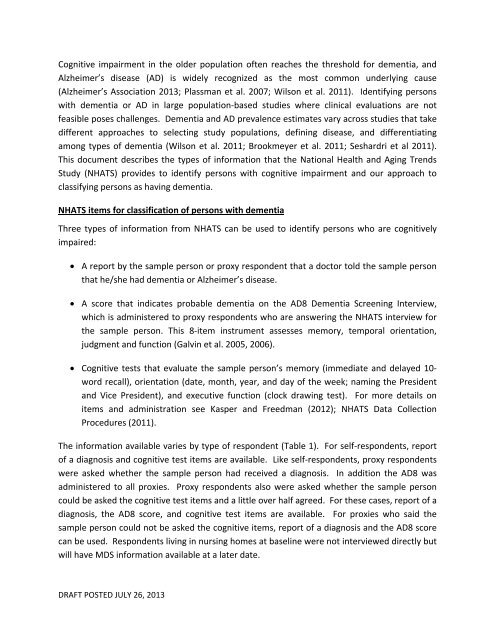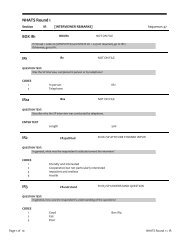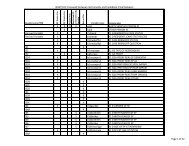Classification of Persons by Dementia Status in the ... - NHATS
Classification of Persons by Dementia Status in the ... - NHATS
Classification of Persons by Dementia Status in the ... - NHATS
Create successful ePaper yourself
Turn your PDF publications into a flip-book with our unique Google optimized e-Paper software.
Cognitive impairment <strong>in</strong> <strong>the</strong> older population <strong>of</strong>ten reaches <strong>the</strong> threshold for dementia, and<br />
Alzheimer’s disease (AD) is widely recognized as <strong>the</strong> most common underly<strong>in</strong>g cause<br />
(Alzheimer’s Association 2013; Plassman et al. 2007; Wilson et al. 2011). Identify<strong>in</strong>g persons<br />
with dementia or AD <strong>in</strong> large population-based studies where cl<strong>in</strong>ical evaluations are not<br />
feasible poses challenges. <strong>Dementia</strong> and AD prevalence estimates vary across studies that take<br />
different approaches to select<strong>in</strong>g study populations, def<strong>in</strong><strong>in</strong>g disease, and differentiat<strong>in</strong>g<br />
among types <strong>of</strong> dementia (Wilson et al. 2011; Brookmeyer et al. 2011; Seshardri et al 2011).<br />
This document describes <strong>the</strong> types <strong>of</strong> <strong>in</strong>formation that <strong>the</strong> National Health and Ag<strong>in</strong>g Trends<br />
Study (<strong>NHATS</strong>) provides to identify persons with cognitive impairment and our approach to<br />
classify<strong>in</strong>g persons as hav<strong>in</strong>g dementia.<br />
<strong>NHATS</strong> items for classification <strong>of</strong> persons with dementia<br />
Three types <strong>of</strong> <strong>in</strong>formation from <strong>NHATS</strong> can be used to identify persons who are cognitively<br />
impaired:<br />
• A report <strong>by</strong> <strong>the</strong> sample person or proxy respondent that a doctor told <strong>the</strong> sample person<br />
that he/she had dementia or Alzheimer’s disease.<br />
• A score that <strong>in</strong>dicates probable dementia on <strong>the</strong> AD8 <strong>Dementia</strong> Screen<strong>in</strong>g Interview,<br />
which is adm<strong>in</strong>istered to proxy respondents who are answer<strong>in</strong>g <strong>the</strong> <strong>NHATS</strong> <strong>in</strong>terview for<br />
<strong>the</strong> sample person. This 8-item <strong>in</strong>strument assesses memory, temporal orientation,<br />
judgment and function (Galv<strong>in</strong> et al. 2005, 2006).<br />
• Cognitive tests that evaluate <strong>the</strong> sample person’s memory (immediate and delayed 10-<br />
word recall), orientation (date, month, year, and day <strong>of</strong> <strong>the</strong> week; nam<strong>in</strong>g <strong>the</strong> President<br />
and Vice President), and executive function (clock draw<strong>in</strong>g test). For more details on<br />
items and adm<strong>in</strong>istration see Kasper and Freedman (2012); <strong>NHATS</strong> Data Collection<br />
Procedures (2011).<br />
The <strong>in</strong>formation available varies <strong>by</strong> type <strong>of</strong> respondent (Table 1). For self-respondents, report<br />
<strong>of</strong> a diagnosis and cognitive test items are available. Like self-respondents, proxy respondents<br />
were asked whe<strong>the</strong>r <strong>the</strong> sample person had received a diagnosis. In addition <strong>the</strong> AD8 was<br />
adm<strong>in</strong>istered to all proxies. Proxy respondents also were asked whe<strong>the</strong>r <strong>the</strong> sample person<br />
could be asked <strong>the</strong> cognitive test items and a little over half agreed. For <strong>the</strong>se cases, report <strong>of</strong> a<br />
diagnosis, <strong>the</strong> AD8 score, and cognitive test items are available. For proxies who said <strong>the</strong><br />
sample person could not be asked <strong>the</strong> cognitive items, report <strong>of</strong> a diagnosis and <strong>the</strong> AD8 score<br />
can be used. Respondents liv<strong>in</strong>g <strong>in</strong> nurs<strong>in</strong>g homes at basel<strong>in</strong>e were not <strong>in</strong>terviewed directly but<br />
will have MDS <strong>in</strong>formation available at a later date.<br />
DRAFT POSTED JULY 26, 2013




